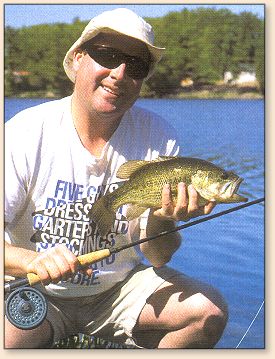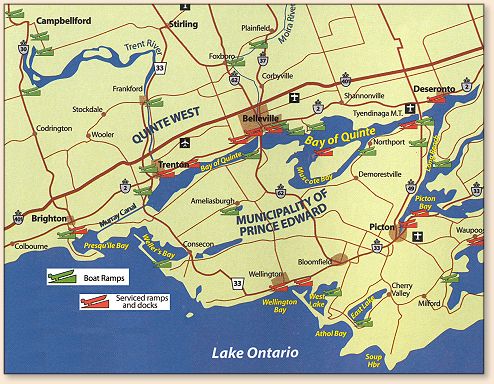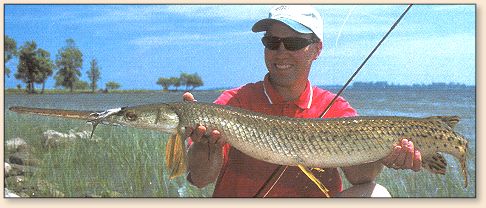 By Chris Marshall
Apart from a temporary absence from 1968-1971,
I've lived in the Quinte region since 1966. When I
first arrived to take up a teaching post in
Belleville, after two years of trout and salmon
cornucopia in New Brunswick and another two in
Quebec's Eastern Townships, I found the region a
bit of a let down: there were few streams with
trout - and those were mainly small and tangly.
However, it didn't take me long to discover the
bounty of warm water fishing which was available.
Today, with the growth of the Lake Ontario salmon
and trout fishery and the booming largemouth and
smallmouth fishery on the Bay of Quinte, that bounty
is even richer than it was thirty five years ago.
It's the home water of The Canadian Fly Fisher,
and it's my pleasure to invite you to share it.
By Chris Marshall
Apart from a temporary absence from 1968-1971,
I've lived in the Quinte region since 1966. When I
first arrived to take up a teaching post in
Belleville, after two years of trout and salmon
cornucopia in New Brunswick and another two in
Quebec's Eastern Townships, I found the region a
bit of a let down: there were few streams with
trout - and those were mainly small and tangly.
However, it didn't take me long to discover the
bounty of warm water fishing which was available.
Today, with the growth of the Lake Ontario salmon
and trout fishery and the booming largemouth and
smallmouth fishery on the Bay of Quinte, that bounty
is even richer than it was thirty five years ago.
It's the home water of The Canadian Fly Fisher,
and it's my pleasure to invite you to share it.

STILLWATERS
The Bay of Quinte
The Bay of Quinte is a long, doglegged inlet full
of shallow bays, which runs eastwards from Carrying
Place to Adolphustown Reach. On the south shore is
the almost-island of Prince Edward County, connected
to the mainland by a narrow isthmus at Carrying Place.
I didn't fish the Bay much when I first arrived. It
was so unnaturally enriched with phosphates from
agricultural run-off and inadequate sewage treatment
that the water resembled pea soup, shutting out the
sunlight and preventing aquatic weed growth. There
were a few pike, bass and walleye (mainly where
rivers entered), but the bulk of the biomass was
white perch, panfish, eels and carp.
However, this changed dramatically in the late 1970's
after municipalities installed tertiary sewage
treatment facilities and measures were taken to
curtail agricultural run-off. Gradually, the water
began to clear, aquatic vegetation returned to the
margins, and the gamefish followed. While the bass
and pike populations grew, the walleye population
far outstripped them, so that by the early 1980's,
the Bay had become a prime destination for walleye
anglers, not only from Ontario and Quebec, but also
from the northeastern USA, particularly New York
and Pennsylvania.
But this was an ecosystem in a state of flux: it
continued to change. The Bay had been identified
as one of the problem spots in the Great Lakes by
the International Joint Commission, and measures
initiated by the Remedial Action Plan (RAP) reduced
the phosphate levels even further. Then came the
invasion of the zebra mussels in the early 1990's.
These tiny molluscs feed by filtering micro-organisms
from the water.
Consequently, the combined effects of the RAP and the
zebra mussels clarified the water so much more that
the growth of aquatic weeds burgeoned, spreading
though all the shallower areas of the Bay. The clearer
water also caused the photophobic walleye to seek
refuge in deeper water and in the burgeoning weedbeds.
Although in somewhat lesser numbers, the walleye are
still there, but in different places than they were
when the water was less clear. Today, the minor decline
in the walleye has been more than offset by the phenomenal
growth in the bass population, both largemouth and
smallmouth. Moreover, from the fly fisher's point of
view, this is a significant improvement-walleye are
not exactly prime targets for the fly rod.

Bass, unlike walleye, thrive in clear water. They need
the clarity to forage. Pike and muskie, which have the
same requirements, are also on the rebound. Consequently,
the Bay of Quinte offers superb fly fishing for both
smallmouth and largemouth bass. To this, add pike, musky,
longnose gar, and carp.
Access
While much of the Bay is shallow (under 15'), direct
access is limited due to extensive cattail marshes,
littoral willows and private property. Consequently,
boats and float-tubes offer the best opportunities.
There are boat ramps in all the communities along
the Bay, and there are plenty of places where float
tubes, kick boats, and canoes can be launched,
especially at culverts, bridges and in parks and
conservation areas. In Belleville, there is also
access for float tubing and wading along well-maintained,
public shoreline trails.

Fishing
Smallmouth and largemouth populations are still growing,
in both numbers and size, with specimens over four pounds
taken regularly. The shallow bays, creek mouths, floating
cattail rafts, and uncountable weedlines near deeper water
offer perfect largemouth habitat. While these are found
throughout the Bay, these are most numerous at the west
end. The best smallmouth fishing is in the less weedy
areas, around rocky shoals close to deeper water. The
best of these are found east of Belleville, especially
adjacent to the cliffs in Picton Bay and in the Telegraph
Narrows near Deseronto. Surface lures are best in the
evening, early morning, and on cloudy days. Subsurface
lures fished with a fast sinking poly leader or a
sink-tip line work best in the heat of the day. Bass
fishers will pick up plenty of pike incidentally, and
even the occasional musky and freshwater drum.

The Bay has unusually large areas of shallow flats
which are perfect for wading. The bottom is a mixture
of limestone bedrock and packed rubble. Here, the fly
fisher can stalk longnose gar up to ten pounds and carp
to over forty. The shallow water warms up quickly and,
in the summer, gar move in to sun themselves, lurking
around weedbeds and deeper pockets in the bedrock, where
pods of them are easily spotted in the clear water. The
best way to target them is to cast big, flashy streamers
just beyond and ahead of them, and worked enticingly past
their noses. They're not too easily spooked, and it's
possible to get quite close to them. As gar have long,
bony snouts filled with sharp teeth, it's best to
incorporate a trailing stinger hook in the fly to
facilitate hook-ups. A section of wire in the leader
helps to prevent bite-offs. While some fish are content
to simply splash around a bit when hooked, a good number
will make spectacular, tail-walking runs. It's not exactly
like fishing tropical flats for bonefish, but it's close.
In June, prior to spawning, carp cruise in small pods
along the shallow margins, especially where there are
cattails. By lurking unobtrusively (carp are easily
spooked) right in the cattails, it's possible to cast
a weighted nymph to individual fish as they cruise
past. These fish are big, strong and tireless, making
long, powerful runs out into deep water. Consequently,
at least a 9 weight outfit with a long rod and a
minimum of 100 yards of backing is essential. Most
fish taken will be between 10 and 25 pounds, but
there are plenty of bigger fish up to over 40 pounds.
Prince Edward County Lakes
There are a couple of small inland lakes, Consecon
and Roblin (where the poet, Al Purdy, had a summer
home), in Prince Edward County which offer good
popper fishing for largemouths, but the best lakes
lie along the Lake Ontario shoreline. These were
originally bays which have been sealed off from
the main lake by gravel bars and sand dunes, leaving
just a narrow outlet between the two. The main ones
are East Lake, West Lake, Pleasant Bay, and Wellers
Bay. All have excellent fly fishing for bass and pike,
with access for both trailered boats and float tubes.
The outlet from West Lake in the village of Wellington
also has opportunities for fly fishing for steelhead
and salmon in the fall from a long, stone jetty which
thrusts out into Lake Ontario.
The south-east promontory of the County, which ends
at Long Point, and the shores of the nearby offshore
islands offer excellent smallmouth fishing in Lake
Ontario. Here, there are low, limestone cliffs, and
the water drops off quickly to 100 feet or more. A
boat is essential, as this is big water. Smallmouth
congregate along rocky shoals and drop-offs, where
they can be taken with big streamers and Woolly Buggers
on full sinking lines during the day and on surface
poppers and shallow running minnow patterns in the
evenings, when the surface is alive with baitfish.
Rainbows and the occasional brown are taken
incidentally and, in the fall, lake trout.
~ Chris Marshall
Continued next time!
Our Man In Canada Archives
|





